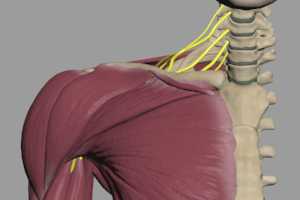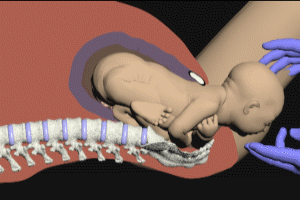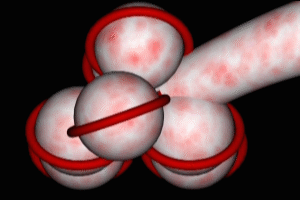3D Medical Animation for Trial
3D Medical Animation for Trial
Summary of article headings: (click on heading to navigate to that section)
Admissibility and Federal Rules of Evidence
3 Dimensional animation is rapidly becoming the gold standard in American courtrooms as a medium for demonstrative evidence in med-mal and personal injury cases with medically-related elements. The reasons for 3D animation’s superiority as a demonstrative tool are multi-fold.
3D vs 2D
2D animation involves creation of a series of drawings which are then viewed in sequence to create the illusion of motion (ie- a Mickey Mouse cartoon). Many companies who specialize in medical illustrations, also offer medical “animations” which are in reality simply a series of their drawings strung together. Illustrators use ingenious artistic techniques to suggest 3d space, but in the final analysis, the illustration universe is a 2 dimensional one; it can show us the view from only one perspective at a time.
(Caveat: This is not to say that illustrations have no utility in the 21st century courtroom – quite the contrary. I still produce a fair number of illustrations each year for clients. They continue to be useful in emphasizing static concepts, and in fact, I am often asked to produce still drawings from particular key frames of an animation I have produced so that clients can really dwell on a particular key point with the jury.)

In 3 Dimensional animation (which we use exclusively), we begin by building 3 dimensional models in the virtual space of the computer screen. These models can then be manipulated and viewed from any desired perspective, much as we might hold an object in our hand and turn it from side to side. Groups of models can be viewed simultaneously from a particular perspective, and then in real time, the point of view can be changed to reveal the spatial relationships of the models. This is an invaluable technique in examination of the human body, whose components are structured and organized in an often complex tangle, unlike the neat geometrically defined forms and spaces familiar to us in our daily experience. The multifaceted articulation of the spinal vertebra, the circuitous route of the nerves of the brachial plexus and their relationship to the shoulder musculature, and the anatomy of the heart are but a few of thousands of examples of the body’s non-linear architecture. In a relatively brief period of time, animation can reveal these intricate structures with a clarity and impact impossible with other techniques.
Motion in 3D Medical Animation

The dimensional advantages of 3D animation are just the beginning, for the ability to portray movement is where animation really excels. If a picture is worth a thousand words, then an animated sequence is worth 30 pictures (or frames) per second. Through 3D animation, we can reveal not only the spatial relationships of anatomy but also how that anatomy functions. How does an embolism obstruct pumonary arteries, what is the precise motion of a fetus as it traverses the birth canal, how does a traumatic hemorrhage in the brain evolve from an arteriovenous malformation, what is the mechanism of infectious spread from a localized wound to the generalized bloodstream? Because animation permits us to simulate motion, a brief sequence can render concrete a concept that would otherwise remain an abstraction when explained via pure verbal testimony or a series of illustrations.
Macroscopic/microscopic

Another strength of the 3D animated sequence relates to the macro-micro concept of human biology. The body consists of functions at 2 very different levels – the macroscopic level – for example the motion of the heart as it propels blood through the lungs, and the microscopic level – the transfer of oxygen molecules from the pulmonary alveoli to the capillaries. In a matter of seconds, an animated sequence can take us from the macro world to the micro world, and back again, and do it with complete continuity. This provides an enormous advantage in clarification of complex physiologic processes.
Limitless possibilities
With animation, you are really limited only by your imagination as far as the variety of techniques possible to tell the story of your case. An example of this versatility is a technique I refer to as “Information Overlay”. Because we are not dealing with a static image in an animated sequence, but instead have an image that is constantly evolving, we can bring additional information in and out of a sequence by overlaying it onto our background.
Rooting out inconsistencies
Last, but by no means least, on the list of benefits of creating animation for a medically-related case is that it really forces you to examine your case in minute detail. As a result, such an analysis can reveal and help to resolve ambiguities in the details of your case before they suddenly rear their heads in the courtroom or at the settlement table. A well produced animation is never ambiguous in the information it is conveying to its audience. To be maximally effective, it has to be as highly detailed and as precise as possible. I have yet to animate a case where there were not at least one or two questions that arose regarding the details of a procedure or biological phenomenon as the project went forward. The result is that the whole legal team, attorneys, experts and animator alike, end up on the same page regarding the facts and theory of the case. As an attorney, you are only too familiar with the fact that the success or failure of your case may hinge upon such details.
3D Medical Animation for Trial: Admissibility and the Federal Rules of Evidence
Admissibility is a key issue for any form of evidence (demonstrative or substantive). Animation is no exception, and because of its ability to convey information in such a dramatic fashion relative to other media, the issue is potentially more problematic. However, I think if you respect certain guidelines in producing medical animation, you will successfully immunize your project against such challenges.
Rules of Evidence 401 and 403
Rules 401 and 403 of the Federal Rules of Evidence are commonly applied by judges to the admission of a medically-related animated sequence. Rule 401 states that irrelevant evidence is not admissible at trial. Rule 403 codifies the common law power of a judge to exclude otherwise relevant evidence “if its probative value is substantially outweighed by the danger of unfair prejudice, confusion of the issues, or misleading the jury, or by considerations of undue delay, waste of time, or needless presentation of cumulative evidence.” It is therefore of utmost importance that a medically-related animation conform to both of these rules.
Rule 401
Let’s start with Rule 401 – i.e. relevancy of the animation. Human anatomy and physiology represents a field of expertise which is not typically within the understanding of a typical lay juror. Moreover, medical experts use a proprietary language when describing medical concepts. Even the most jury-friendly medical expert when giving verbal testimony must by necessity utilize a plethora of terms that are indecipherable to the typical lay juror. Attorneys often spend valuable court time attempting to extract understandable paraphrases from such witnesses, with a resultant loss of focus on the issues at hand. It is, therefore, not difficult to justify the relevance of any demonstrative evidence, including animation, which helps to clarify the issues at hand in such cases.
Rule 403
Satisfying Rule 403 can be a little trickier. The key words here are “…the danger of unfair prejudice, confusion of the issues, or misleading the jury…”. 3D animation can certainly have a dramatic impact on a jury’s understanding of the issues at hand, but if the animation’s content is seen to trigger an emotional or sensational response from the jury, or if the images portray details of a medical phenomenon or procedure which are speculative, a judge will be more likely to disallow.
Adherence to two guidelines here can avoid Rule 403 issues:
1) the animation should reflect as closely as possible your medical expert’s theory of the case.
2) inclusion of any speculative elements should be strictly limited to speculation by your expert which is contained in deposition and to which the expert has agreed to testify.
To accomplish this, before I start building models and animating on a particular case, I spend as much time as is needed reviewing medical records and discussing the critical concepts of the case with both my clients and their experts until I am satisfied that I have a detailed understanding of what it is that I’m going to be portraying. Then once I’ve completed a first draft, I submit this to both clients and experts and we agree on any changes necessary to maximize medical accuracy, courtroom impact, and evidentiary admissibility. The revision process does not have arbitrary limits. If I’ve done my homework up front, the revisions are generally relatively minor and rapidly accomplished, but of necessity, in some case several revisions are required to fine tune the final product. What we’re aiming for is for the animation to be an exact visual representation of our medical and legal theory of the case, in essence, for the animation to be the expert’s testimony within the legal framework of the case.
3) avoid the use of images in the animation which may trigger an emotional response in the jury.
The human body, its functions and its dysfunctions can be a very messy business. The internal workings of the human body, fluids and all, is likely to inspire feelings of queasiness, nausea or even outright revulsion in jurors not accustomed to such sights, even when portrayed in an animated form. The use of an animated sequence for this purpose will almost always increase the chances for rejection by the court. Examples of this could include portrayal of the spilling of any type of bodily fluid as a result of injury, be it blood or therwise; depiction of painful or obviously depressed facial expressions on human models utilized in the sequence and the mishandling of instruments portrayed in a procedure. Depictions of this nature may be difficult to get admitted as they are often highly speculative, can’t be verified in the factual record, and may be considered as merely a means to create shock value in the minds of the jury.

It is important to emphasize the word gratuitous in the preceding paragraph, because there may be instances in which portrayal of the aforementioned processes are completely appropriate, and even essential, to a proper understanding of the case. The video above “Discreet Portrayal if Bodily Fluids…” touches several bases in this regard, with cauterization of pelvic tissue, bleeding and leakage of urine from an injured ureter. This animation was used at trial and was admitted by the presiding judge over the objections of opposing counsel. Provided such instances are handled with a modicum of restraint and with the approval of experts, their presence in the animation should not hinder admissibility.
Finally, the majority of my clients prefer to admit the animation as demonstrative evidence, that is, evidence that supports or illustrates the testimony of medical experts in the case. Attempts to admit animation as substantive evidence may increase the risk of exclusion. Even though the animation may then be submitted successfully as demonstrative evidence, it will appear tainted in the eyes of the jury
Medical Animation as a Settlement tool
It’s important to make the point that while our primary focus in crafting an animation is with respect to ultimately presenting it to a jury at trial, many cases will settle prior to trial.
More often than not, my clients submit the animated presentation to opposing counsel well ahead of the trial date and/or will use it for a pre-trial mediation.
A well designed animation, with its very concise visual delineation of plaintiff’s or defendant’s case, can crystallize the strengths of that case in the minds of opposing counsel (just as it can in the mind’s of the jury), and can therefore act as a catalyst in precipitating a settlement.
Project length and time to complete
The length of an animation is strictly determined by the complexity of the specific case and the number of salient points to be made, but in my experience, a two minute project is generally the minimum length required for a properly done animation. On the other hand, I have produced as much as thirty minutes of animation (composed of several separate segments) for presentations in complex cases.
Time to complete the project also hinges primarily on the complexity and length, but is also influenced by the number of experts and/or attorneys involved in the case, and of course deadlines for mediations & settlement conferences, and trial dates. I generally like to have at least a few weeks to create initial drafts, have them vetted by my clients and their experts and make revisions, but I have produced shorter projects in as little as several days.
The advent of the internet has greatly facilitated the ease with which draft versions, revisions and final versions of a project can be transmitted for client and expert review, and has eliminated the need for animator and client to reside in the same geographic area.
I post draft versions online in a private viewing site accessible by a link emailed to the client/experts.
Final version video files are uploaded on our end to a private storage area. These files can then be downloaded with ease on the client’s end.
3D Medical Animation Media type and Playback
Today’s digital video formats provide superior image, color and sharpness, and permit razor-sharp still images when pausing during playback, as well as flexibility and ease in moving from one section of a project to another.
We typically output video files in mpeg-4 format, though we can output in a variety of different formats should your IT needs require.
MPEG-4 video files can be copied to CD-ROM or thumb drives for storage or portability, but we generally recommend playback of files directly from the hard drive of your computer for smooth operation.
Most courtrooms in the country are now equipped with multiple monitors or big screens for playback from your computer, but occasionally, I’ll have a client in an outlying area use their own projector and screen setup at trial.
Cost
The cost of custom 3D animation is directly related to length, and therefore, will vary with the complexity of the case. As mentioned previously, 2 minutes of animation seems to be about the minimum length required for simpler projects, whereas most projects seem to fall between 2-7 minutes in length. The cost of 3 Dimensional animation must be seen in terms of its unparalleled ability to convey huge quantities of highly technical information in a short period of time, and in a comprehensible fashion. In most instances, alternative media and methods really can’t compare, and when you consider that a few minutes of animation is about the same cost as 3 or 4 professional custom illustrations, animation’s value is clear. You can get more information on Custom Animation here.
Stock 3D Medical Animation
I have built a large library of stock animation over the past 20 years. These segments represent a tremendous value, and may be purchased as is, or, I can customize them to match the needs of your particular case (additional hourly fee). Either way, stock animation is very economical when compared to a custom project, though there may be limitations. The details of your particular case must be at least somewhat similar to the Stock segment, or the amount of customization necessary may make the cost greater than production of a Custom project. Please click here for much more information on stock animation, or here to view the stock animation library.
Cal Shipley, M.D. copyright 2020
